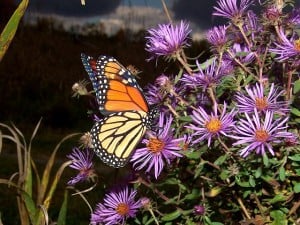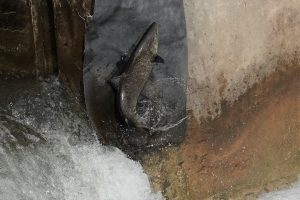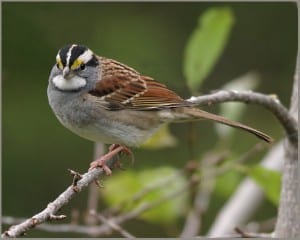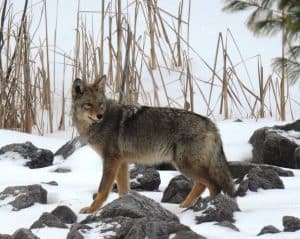Looking ahead to events in nature in the Kawarthas
Although we enjoyed a comfortable summer in the Kawarthas – sunny, not too hot, and no extreme weather – the biggest story for the planet as a whole continues to be the climate crisis. July was Earth’s hottest month since temperature records began. The unparalleled heat of July followed the hottest June on record. Many European countries experienced the hottest days in their nations’ history. Scientists agree that these record-breaking temperatures are almost entirely due to climate change.
Just this week, we also saw the unimaginable destruction in the Bahamas from Hurricane Dorian. New research is now linking the more extreme behaviour of these storms to global heating. Because a warmer atmosphere holds more moisture, hurricanes are dumping more rain than in the past. Warmer oceans also provide additional energy that make the storms stronger. The fact that hurricanes like Dorian are moving more slowly than in the past – and even stalling – may be linked to decreased atmospheric wind speeds as a result of a warming Arctic.
A more heartening story this summer has been the abundance of monarch butterflies. This is the third summer in a row with good numbers of this species at risk. For example, on the July 21 Petroglyphs Butterfly Count, nearly 500 monarchs were tallied – twice last year’s number! Several factors have come together to boost the numbers of this iconic insect. First, the overwintering population in Mexico was 144 per cent higher than 2018, which meant more monarchs headed north. As they migrated, laying eggs along the way, good weather conditions boosted reproductive success. Finally, this summer’s warm weather and sufficient rainfall allowed milkweed and nectar plants to thrive, which allowed for excellent reproductive success. We can also speculate that gardeners and landowners are helping the cause, since so many of us are now planting milkweed in our gardens or simply leaving them be.
This summer was also excellent summer for fireflies. Apparently, the wet spring created perfect conditions for worms, slugs and snails, all of which provide food for firefly larvae. Of special note, too, is the abundant fruit this year on apple trees, chokecherries, dogwoods, wild grape, and even the endangered butternut. The big cone crop on spruce and cedar is also noteworthy.
Looking ahead to the fall, here is a list of events in nature that are typical of autumn in the Kawarthas – an autumn that once again is projected to be warmer than usual.
September
· Most of the evening insect music we hear this month comes courtesy of crickets. Listen for the soft, rhythmic “treet…treet…treet” of the snowy tree cricket. Its beautiful rhythmic pulsations provide a good estimate of air temperature. For the temperature in Celsius, count the number of “treets” in 8 seconds and add 5. Watch and listen at bit.ly/18nGrJ3
· Watch for giant swallowtails, Canada’s largest butterfly. They regularly turn up in backyard gardens, even right in Peterborough. With a wingspan of up to 15 cm and striking yellow and black coloration, they are easy to identify. The northern expansion of this southern species is related to a warming climate.
· Fall songbird migration is now in full swing. Migrants such as warblers are often in mixed flocks with chickadees and can be coaxed in for close-up views by using “pishing”.
· Broad-winged hawks migrate south over the Kawarthas in mid-September. Sunny days with cumulous clouds and northwest winds are best. Watch for high-altitude “kettles”, which is a group of hawks soaring and circling in the sky. Migration usually peaks on about September 15.
· Listen for the constant calling of blue jays and the metronome-like “chuck-chuck…” call of chipmunks, which can go on for hours. This vocalization is often given in response to danger such as the presence of a hawk.
· Peterborough Field Naturalists (PFN) we be holding nature walks each Sunday in September. They usually last about three hours. The meeting spots are Riverview Park and Zoo (Sept. 8 at 8:00 am), the public parking lot on Crawford Drive at Harper Road (Sept. 15 at 1:00 pm), Country Style at Hwy 7 and Old Keene Road (Sept. 22 at 8:00 am), and Cavan Carpark/GO Bus Stop (Sept. 29 at 8:00 am). For more information, go to peterboroughnature.org
· The PFN indoor meetings take place on the second Wednesday of each month (7:30 pm) at the Camp Kawartha Environment Centre at 2505 Pioneer Road. On September 11, Mike Burrell will speak about his new book, “The Best Places to Bird in Ontario”.
· Chinook and coho salmon leave Lake Ontario to spawn in tributaries of the Ganaraska River. Huge salmon can be seen jumping up the fish ladder at Corbett’s Dam on Cavan Street in Port Hope.
· As the goldenrods begin to fade, asters take centre stage. The white flowers of heath, panicled and calico asters, along with the purple and mauve blossoms of New England, purple-stemmed and heart-leaved asters provide much of the show. Visit http://bit.ly/2fhW4sN (Ontario Wildflowers) for identification tips.
· Don’t miss the spectacular Harvest Moon, which occurs this year on September 14, rising at 8:06 pm. The Harvest Moon is the full moon closest to the fall equinox (September 23). For several nights before and after this date, the moon rises at almost the same time.
October
· Fall colours in the Kawarthas usually peak early in the month. Right now, it looks like we can expect a great colour show this fall, given that trees flourished this summer thanks to a wet spring and warm July and August. County Roads 620 and 504 around Chandos Lake east of Apsley makes for a great colour drive.
· On October 9, Ken Lyon will speak to the PFN on “The Geological Features of the Land Between”. The talk will include the geology of the Canadian Shield and the St. Lawrence Lowlands as well as the drumlins and other features left by the glaciers. See above for location and time.
· Sparrow migration takes centre stage this month, making October one of the busiest times of the year for backyard feeders. Scatter millet or finch mix on the ground to attract dark-eyed juncos and both white-throated and white-crowned sparrows.
· On balmy October days, ruffed grouse can sometimes be heard drumming. Early fall is also the grouse’s “crazy season.” Young birds disperse from their parent’s territory and often end up colliding with all manner of objects.
· A tide of yellow spreads across the landscape in mid- through late October. The colour is supplied courtesy of trembling and bigtooth aspens, balsam poplar, silver maple, white birch and, at month’s end, tamarack.
· As ducks move southward, consider a visit to the Lakefield sewage lagoon. It is located on the south side of County Road 33, just south of Lakefield. Goldeneye, buffleheads, scaup and mergansers are often present in large numbers. If you have a spotting scope, be sure to take it along. The sewage lagoon is one of the best birding locations in the Kawarthas.
· The first northern finches usually start turning up in late October. To learn which species to expect this fall and winter, Google “winter finch forecast 2019-2020”. The forecast, compiled by Ron Pittaway, is usually available online by early October.
November
· Oaks, tamaracks and silver maples are about the only native deciduous trees that still retain foliage in early November. The brownish orange to burgundy leaves of red oaks stand out with particular prominence.
· We return to Standard Time on Sunday, November 3, and turn our clocks back one hour. Sunrise on the 3rd is at 6:52 am and sunset at 5:00 pm for a total of only 10 hours and 8 minutes of daylight.
· If you go for a woodland hike, watch for clusters of small, fan-shaped fungi growing on logs or dead trees. If the fungus has concentric zones or rings of white, cream, yellow, and brown, you are probably looking at turkey tail fungus, one of our most attractive species.
· Most of our loons and robins head south this month. However, small numbers of robins regularly overwinter in the Kawarthas. This year’s huge wild grape crop will probably mean that larger than average numbers of robins will choose to remain here like they did two years ago.
· Coyotes are often heard in late fall. The coyotes of central Ontario are closely related to the eastern wolf (Canis lycaon) and the two species sometimes hybridize. All wolf-like animals of Peterborough County contain, to varying degrees, both coyote and eastern wolf genes.
· This is a great time of year to focus on several groups of plants of the forest floor that usually escape our attention. Evergreen ferns, club-mosses, and mosses stand out prominently against the brown leaf litter. Watch for wood fern, rock polypody fern, ground pine and ground cedar club-mosses, juniper moss, and fire moss.
CLIMATE CRISIS NEWS
On September 11, Peterborough Youth Empowerment will hold a forum to discuss what Peterborough can do at the municipal level to address the Climate Crisis. The meeting takes place at the Peterborough Public Library from 6:00 to 7:30 pm. Robert Kiley, a Kingston municipal councillor, will explain how his council found the will to declare a Climate Emergency and how Peterborough can follow suit. Local climate activist, Al Slavin, will speak on some of the actions that are possible at the municipal level. Other climate events scheduled for the coming weeks include the Global Climate Action Day (Sept. 27 at Millennium Park from 12:00-3:00 pm) and 100 Debates on the Environment (Oct. 3 at Trinity United Church from 7:00 – 9:00 pm). The quickly worsening climate crisis should be top-of-mind when we cast our votes in October.



